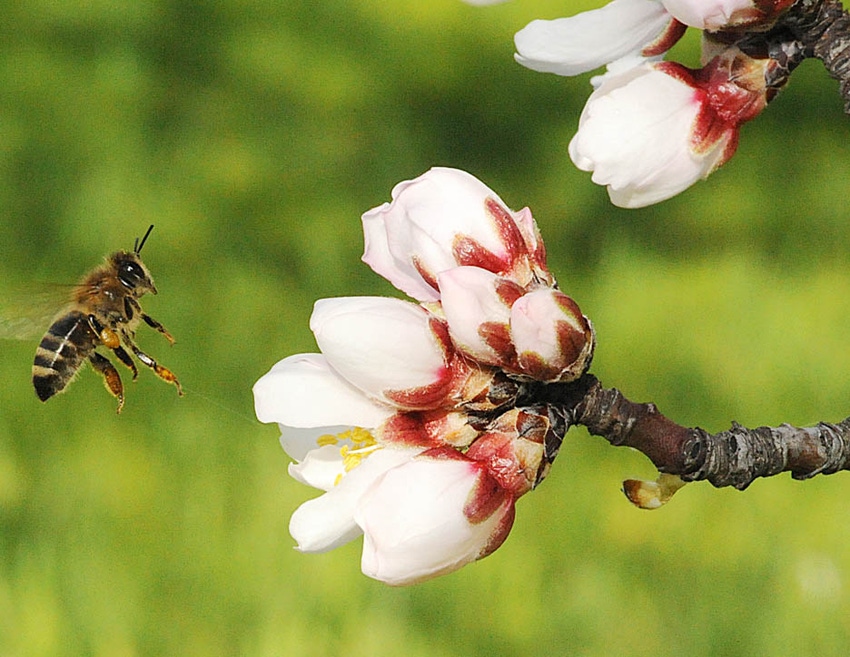
Winter honey bee losses and the resulting fewer bees per hive could spell trouble for almond growers in California."Last year was not a good year for honey production in the United States and it could be one of the worst honey production years in the history of nation, although it’s been pretty rough in some of the previous year."
February 12, 2013

California almond growers may not have enough honey bees to pollinate this year’s crop of 800,000 acres, says Extension apiculturist Eric Mussen of the UC Davis Department of Entomology. He attributes the difficulty to winter losses and less populous hives.
“We need 1.6 million colonies, or two colonies per acre, and California has only about 500,000 colonies that can be used for that purpose,” he said. “We need to bring in a million more colonies but due to the winter losses, we may not have enough bees.”
Those winter losses -- still being tabulated -- and the resulting fewer bees per hive could spell trouble for almond growers, he said.
“Last year was not a good year for honey production in the United States,” Mussen said, “and it could be one of the worst honey production years in the history of nation, although it’s been pretty rough in some of the previous years. Usually when we’re short of nectar, we’re short on pollen, and honey bees need both. So, 2012 was a bad year for bee nutrition.”
Malnutrition is one of the stressors of colony collapse disorder, the mysterious malady first noticed in the winter of 2006 that has decimated one-third of the nation’s bees every year. Some beekeepers have reported winter losses of 90 to 100 percent.
(See related, Honey bee losses defy solitary explanations)
In CCD, the adult bees abandon the hive, leaving behind the queen bee, brood and food stores. Bee scientists think CCD is caused by a multitude of factors, includes, pests, pesticides, parasites, diseases, malnutrition and stress.
“We don’t know how many more bees will be lost over the winter,” Mussen said. “We consider the winter ending when the weather warms up and the pollen is being brought into the hives.”
“Many, many colonies are not going to make it through the winter,” said Mussen, an apiculturist in the UC Davis Department of Entomology since 1976. “We won’t have as large a bee population as in the past.”
Depending on strong colonies
In other words, fewer colonies will be available for the almond growers and the colonies that are available aren’t going to be as populous, he said.” Almond growers usually want at least eight frames of bees per hive,” Mussen said, “but this year they may be lucky to get six. That’s one-third less bees per hive to pollinate the orchards.”
Mussen estimated a good solid hive with eight frames amounts to 2000 bees per frame or 16,000 bees.
Already brokers are getting calls from beekeepers saying “I can’t fulfill the contract. I’m going to be short.”
Mussen said it may all work out well in the end as “bees pollinate almonds on a community basis. The strong colonies will make up for the weak colonies. The strong colonies will clean the orchard of pollen by early afternoon and then go down the street and grab food from nearby orchards.”
(See related, Honey bee conference spotlights need for more research)
San Joaquin almond orchards are already starting to bloom, “but it’s going to be late up here in the Sacramento Valley,” he said. Kern County grows more almonds than any other county in the state.
“If we hit abnormally warm stretches that push out all the bloom at once, that will be good,” said Mussen. “It’s likely that cross-pollination will be better if we have a steady period of warm weather, instead of a warm-cold fluctuating period.”
Although the almond growers are paying a lot of money for their pollination services –an average of $150 per hive—there’s no guarantee it will be a good nut set, Mussen warned. “If it’s too cool, fertilization may not occur. The pollen tubes won’t grow all the way down to the base of the flower to the ovum. The good nut set occurs within the first three days of pollination or at the most, within five days.”
On the other hand, if the weather is too hot and dry, the tissue dries out, he explained. “So we need nice warm weather that’s not too hot or too cold to get good fertilization and nut set. It’s not always the bees’ fault if the nuts fail to grow.”
Many beekeeping operations truck in thousands of colonies to pollinate California’s almonds. One beekeeping operation used to bring 16,000 colonies, Mussen said, “but that 16,000 could be half that this year.” The bees are trucked here from all over the nation.
Around Feb. 14 the average almond orchard in California is in full bloom, but some orchards bloom earlier or later, depending on the cultivar and the weather. An almond orchard blooms a total of about two weeks, he said, pointing out that “the season is short.”
“Around March 7 to the 10th is the last pollination period for almonds in California,” he said. That means that some beekeepers can do double duty with their bees , first pollinating orchards in early February and then heading off to other orchards for the last blooms of the season.”
Almonds are California's biggest export. This year the National Agricultural Statistics Service is forecasting a record-breaking 2.10 billion meat pounds, valued at approximately $3 billion. Eighty-percent of the global supply of almonds is grown in California, and about 70 percent of California’s crop is marketed overseas.
You May Also Like



